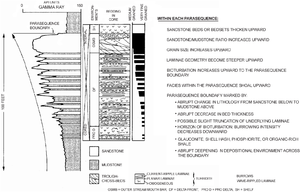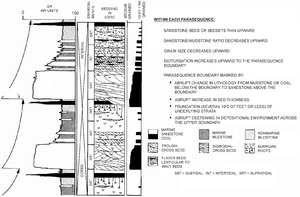Difference between revisions of "Parasequences (fourth- and fifth-order sequences)"
(Initial import) |
Cwhitehurst (talk | contribs) |
||
| Line 18: | Line 18: | ||
==Periodic vs. episodic parasequences== | ==Periodic vs. episodic parasequences== | ||
A parasequence can be either periodic or episodic.<ref name=ch21r48>Weber, L., J., Sarg, J., F., Wright, F., M., 1995, [[Sequence stratigraphy]] and reservoir delineation of the middle Pennsylvanian (Desmoinesian), Paradox basin and Aneth field, southwestern U., S., A., in Read, J., F., Weber, L., J., Sarg, J., F., Wright, F., M., eds., Milankovitch Sea-Level Changes, Cycles, and Reservoirs on Carbonate Platforms in Greenhouse and Ice-House Worlds: SEPM Short Course No. 35, 79 p.</ref> A '''periodic parasequence''' has regional continuity and forms in response to deposition during a global sea level cycle. An '''episodic parasequence''' has limited lateral extent and forms in response to tidal flat migration or delta lobe shifts. Episodic parasequences are of very short duration—generally less than 10,000 years. Periodic parasequences have average durations of 100,000 years. | A parasequence can be either periodic or episodic.<ref name=ch21r48>Weber, L., J., Sarg, J., F., Wright, F., M., 1995, [[Sequence stratigraphy]] and reservoir delineation of the middle Pennsylvanian (Desmoinesian), Paradox basin and Aneth field, southwestern U., S., A., in Read, J., F., Weber, L., J., Sarg, J., F., Wright, F., M., eds., Milankovitch Sea-Level Changes, Cycles, and Reservoirs on Carbonate Platforms in Greenhouse and Ice-House Worlds: SEPM Short Course No. 35, 79 p.</ref> A '''periodic parasequence''' has regional continuity and forms in response to deposition during a global sea level cycle. An '''episodic parasequence''' has limited lateral extent and forms in response to tidal flat migration or delta lobe shifts. Episodic parasequences are of very short duration—generally less than 10,000 years. Periodic parasequences have average durations of 100,000 years. | ||
| + | |||
| + | [[file:exploring-for-stratigraphic-traps_fig21-12.png|left|thumb|{{figure number|1}}.]] | ||
==Parasequence sets== | ==Parasequence sets== | ||
A parasequence set is a succession of genetically related parasequences that forms a distinctive stacking pattern. A parasequence set is generally bounded by a marine flooding surface.<ref name=ch21r45 /> | A parasequence set is a succession of genetically related parasequences that forms a distinctive stacking pattern. A parasequence set is generally bounded by a marine flooding surface.<ref name=ch21r45 /> | ||
| + | |||
| + | [[file:exploring-for-stratigraphic-traps_fig21-13.png|thumb|{{figure number|2}}.]] | ||
==Upward-coarsening parasequence== | ==Upward-coarsening parasequence== | ||
| − | + | [[:file:exploring-for-stratigraphic-traps_fig21-12.png|Figure 1]] below shows the characteristics of an upward-coarsening parasequence formed in a deltaic environment. | |
| − | |||
| − | [[file:exploring-for-stratigraphic-traps_fig21-12.png| | ||
==Upward-fining parasequence== | ==Upward-fining parasequence== | ||
| − | + | [[:file:exploring-for-stratigraphic-traps_fig21-13.png|Figure 2]] shows the characteristics of two upward-fining parasequences formed in a tidal flat to subtidal environment. | |
| − | |||
| − | |||
==See also== | ==See also== | ||
Revision as of 19:22, 22 January 2014
| Exploring for Oil and Gas Traps | |

| |
| Series | Treatise in Petroleum Geology |
|---|---|
| Part | Predicting the occurrence of oil and gas traps |
| Chapter | Exploring for stratigraphic traps |
| Author | John C. Dolson, Mike S. Bahorich, Rick C. Tobin, Edward A. Beaumont, Louis J. Terlikoski, Michael L. Hendricks |
| Link | Web page |
| Store | AAPG Store |
Parasequences are deposited during fourth- or fifth-order eustatic cycles. They are generally progradational and have a shoaling-upward association of facies.[1] In siliciclastic parasequences, grain size can either fine or coarsen upward, reflecting an upward decrease in water depth. Some workers[2] consider fourth-order sequences (deposited during cycles 100,000–200,000 years in duration) to be the building blocks of most reservoir or field studies.
Periodic vs. episodic parasequences
A parasequence can be either periodic or episodic.[3] A periodic parasequence has regional continuity and forms in response to deposition during a global sea level cycle. An episodic parasequence has limited lateral extent and forms in response to tidal flat migration or delta lobe shifts. Episodic parasequences are of very short duration—generally less than 10,000 years. Periodic parasequences have average durations of 100,000 years.
Parasequence sets
A parasequence set is a succession of genetically related parasequences that forms a distinctive stacking pattern. A parasequence set is generally bounded by a marine flooding surface.[2]
Upward-coarsening parasequence
Figure 1 below shows the characteristics of an upward-coarsening parasequence formed in a deltaic environment.
Upward-fining parasequence
Figure 2 shows the characteristics of two upward-fining parasequences formed in a tidal flat to subtidal environment.
See also
- Sequence stratigraphy
- Basics of sequence stratigraphy
- Hierarchy of sequences
- Third-order sequences
- Traps in a framework of sequence stratigraphy
References
- ↑ Van Wagoner, J., C., Mitchum, R., M., Campion, K., M., Rahmanian, V., D., 1990, Siliciclastic Sequence stratigraphy in Well Logs, Cores and Outcrops: Concepts for High-Resolution Correlation of Time and Facies: AAPG Methods in Exploration Series No. 7, 55 p.
- ↑ 2.0 2.1 Van Wagoner, J., C., 1995, Overview of sequence stratigraphic foreland basin deposits: terminology, summary of papers, and glossary of sequence stratigraphy, in Van Wagoner, J., C., Bertram, G., T., eds., Sequence Stratigraphy of Foreland Basin Deposits: Outcrop and Subsurface Examples from the Cretaceous of North America: AAPG Memoir 64, p. ix–xxi.
- ↑ Weber, L., J., Sarg, J., F., Wright, F., M., 1995, Sequence stratigraphy and reservoir delineation of the middle Pennsylvanian (Desmoinesian), Paradox basin and Aneth field, southwestern U., S., A., in Read, J., F., Weber, L., J., Sarg, J., F., Wright, F., M., eds., Milankovitch Sea-Level Changes, Cycles, and Reservoirs on Carbonate Platforms in Greenhouse and Ice-House Worlds: SEPM Short Course No. 35, 79 p.

